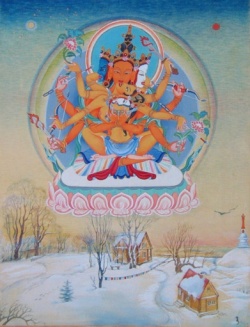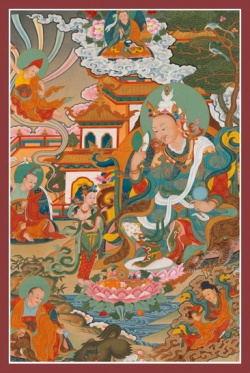The Abhidhamma philosophy
The pali term Abhidhamma is composed of Abhi which means subtle or ultimate, and Dhamma which means truth or doctrine. Abhidhamma therefore means subtle or ultimate truth or doctrine.
All the Teachings of the Buddha can be summed up in one word: Dhamma. Dharma is the Sanskrit form, in the Pali language which the Buddha spoke, it is softened to Dhamma. It means truth, that which really is. As it enables one to realize truth the Doctrine is also called Dhamma.
The word of the Buddha which is originally called Dhamma, consists of three aspects, the doctrinal (Pariyatti), the practical (Patipatti) and the realizable (Pativedha). The doctrinal aspect is preserved in the Scriptures called Three Pitakas or baskets of the Canon. It has been estimated by English translators of the Pitakas to be eleven times the size of the Christian Bible.
This Pitaka which contains the words of the Buddha consists of three baskets, namely the Basket of Discipline (Vinaya Pitaka), the Basket of Discourses (Sutta Pitaka) and the Basket of Ultimate Things (Abhidhamma Pitaka).
The Vinaya Pitaka deals mainly with the rules and regulations of the Order of monks (Bhikkhus) and nuns (Bhikkhunis). It also gives a detailed account of the life, ministry of the Buddha and the development of the Buddhist Order. It is subdivided into five books. The Sutta Pitaka contains the Discourses delivered by the Buddha to individuals or assemblies of different ranks at different places on different occasions. It is divided into twenty-six books. The Abhidhamma Pitaka consists of the four ultimate things: Mind (Citta), Psychic-factors (Cetasikas), Matter (Rupa) and Nibbana. It is the most important and most interesting to a deep thinker. It is subdivided into seven books.
The main difference between the Sutta and the Abhidhamma Pitakas is that in the Sutta the doctrines are explained in the words of conventional, simple language, but in the Abhidhamma everything is analysed and explained in purely philosophical terms true in the absolute sense. Thus, in the Sutta stones are called "stones", animals "animals" and men "men", but in the Abhidhamma realities of psychical and physical phenomena are described and elucidated.
Abhidhamma is a philosophy in as much as it deals with the most general causes and principles of things. It is also an ethical system because it enables one to realize the ultimate goal, Nibbana. As it deals with the working of the mind, thoughts, thought- processes and psychic-factors, it is also a system of psychology. Abhidhamma is therefore generally translated as The Psycho- Ethical Philosophy of Buddhism.
The discourses in the Sutta Pitaka were generally expounded to suit temperaments of different people and so they are rather like prescriptions. In the Abhidhamma Pitaka all these doctrines are systematically elucidated from the philosophical, psychological and physiological standpoint. As such Abhidhamma is underlying all the Teachings of the Buddha. A knowledge of it is therefore essential to understand clearly the Buddhist Doctrine.
Abhidhamma is highly prized by deep thinking students of Buddhist Philosophy but to the average student it seems to be dull and meaningless. The main reason is that it is so extremely subtle in its analysis and technical in treatment that it is very difficult to understand without the guidance of an able teacher.
Of the four ultimate realities with which Abhidhamma deals, one is mind. Now, what is the mind? Mind has been explained by many philosophers and psychologists in various ways.
According to Abhidhamma, mind is power to think, to know. The power of the mind stands no comparison with anything known by us, but we may compare it with the colossal energy inherent in electricity, or perhaps with the atomic power. Even as the electrical power could be utilized for different purposes, good, bad or indifferent, so also our mind. The atomic power now utilized for human destruction could be utilized for the alleviation of the human sufferings as well.
Mind may be said to be like pure, transparent water which can be mixed with anything. When it is mixed with mud, it becomes thick and defiled and you cannot see through. In the same way, this supreme, incomparable energy known as mind, which is by nature clear, bright and transparent, becomes dirty, defiled and poisonous by ill use. Take another power known to us; the steam power. It can be utilized for the purpose of hauling or dragging huge weight of materials under proper control or an intelligent use, if this power is misused, or uncontrolled, the result is disastrous. A steam boat carrying a large number of passengers can bring destruction to life and property if the steam power is not controlled and dexterously used. The abuse of the mind can destroy hundreds of times more than any physical power can. But the same mind, when it is developed and trained for good purposes, can perform wonders. For instance, see the mind of the Buddha who, by the supernormal powers of his well trained mind is able to influence millions of people throughout the world and bring them to light and understanding, to joy and happiness.
A pure mind is defiled by thoughts of greed, anger and ignorance. There are some people who have attained positions of eminence, and because their minds are so defiled, they have brought ruin not only to themselves but also to large sections of the people. They are utilizing their powerful minds to a wrong direction. It is just like a revolver in the hands of a monkey.
Here in this article, for want of space I may deal with only one aspect of the mind to show how it can easily be made impure. I may deal with the aspect that works through the eye. When we see an object, we do not see its real or intrinsic nature, we only see its appearance. An image of the object is formed only if we keep our eyes in the right direction so that the waves of light which have been reflected by it enter our eyes. Though these waves are incessantly beating on the outside of our sense organ, eye, if the eye-lid is closed, they make no sense impressions. It is not then any soul from within us that goes out to seize upon and grasp the object, but the phenomena are, as it were, making their way into our consciousness through the sense door. All our thoughts or concepts based on those sense impressions are therefore, indirect, secondary to truth and not free from personal prejudice. We, therefore, can say we have no direct knowledge of what really exists in the world of physics. Nevertheless the objects in the outside world of physics are real but not as an observer sees them. The objects in the out side world of physics exist independent of our awareness. These physical objects, according to the Buddhist philosophy, consist of four aggregates of elements. Therefore what we see is only the appearance, the image of the object which appears in the retina of our eye. We imagine that what we see is real, but it is our own imagination of appearance. Therefore our knowledge of what we see is composed of appearance. Hence we mistake the appearance for an object, the shadow fort the substance. Ignorance of this nature leads to delusion in which imagination plays a great part, giving rise to craving for what does not exist.
It reminds me of a little story. There once a fox which was looking for something to eat. He stopped at a tree covered red flowers. He looked up and waited till some flowers fell. He then ran towards thinking of eating with relish, because he imagined that what he saw on the tree were some deep red flesh. He smelt it, and his dismay discovered that it was not what he expected. But he did not lose heart. He said, "Not this, but those up there are". He waited; some more bunches of flowers and every time they cam down, he the same experience. Thus he remained whole day starving, imagining that the thing was still on the top of the tree.
We worldly people think that things exist when they do not really exist. We are usually looking for something new and sometimes for things which do not really exist. We look to appearances without realising their intrisic values.
Now, we come to the question whether "I" exist, whether "you" exist. This is common question, It was asked not only the time of the Buddha, but also long before He appeared. The Buddha was asked this question and He has answered it again and again. Still, people have not been satisfied, and today we are asking the same question. According to the Buddhist philosophy, I am real, and you are real, they exist; but they exist not in the way we see them. What we see is an illusion, because what we see, or what we think we see is not real. It is only appearance, a phantom which our mind has created out of appearance or image.
We therefore can say that there are two I's and two you's. The "I" that exists and has being in the world and another "I" that exists only in the world of senses and so is not real. The former "I" exists in its real sense, in its intrinsic value, and can be realized only by a well trained mind, unobscured by the illusory nature of phenomenal existence. According to Buddhist philosophy, this "I" consists of five aggregates. The combination of these five aggregates in varying degrees constitutes the appearances to which we attribute different names. It is right knowledge that makes us discriminate the ultimate nature of things from superficial appearances, the real from the unreal, and truth from imagination.
The object coming to the view of an ordinary man would be seen only in the light of his own limited knowledge, in the light of his own imagination. He does not realize the aggregates that have made up the view represented by the object. He then attaches qualities that are either attractive or repulsive, desirable or undesirable. He often imputes qualities to people, but these qualities are in point of fact created out of his own imagination, because he sees only image of the person concerned. He thereby makes mistakes because he does not go beyond the appearance.
A Buddhist annotator gives this simile in this connection. He says that people who have no insight to the ultimate reality of things are acting like a dog in a story. It appears there was a dog which came across a dry, lean bone. Being hungry, it began to lick it and to try and eat it. In the process its saliva made the bone wet, and it soon began to chew the bone with great relish imagining that it was a fat, juicy flesh.
An ordinary worldly observer is like the dog in the story. He imagines to be happy when he really is not. He imagines some thing to be substantial, and therefore permanent, when in point of fact, by its very nature, it is the reverse. He imagines something which really does not exist, thus giving rise to sorrow, worry, suffering.
We talk of attractive and distractive qualities. Now, do these qualities exist? According to Buddhist philosophy, there is nothing definite, because what is agreeable or desirable to one may be disagreeable or undesirable to another. Qualities are usually thought to be good or bad accordingly as one imagines. A dead flesh that appears to us to be bad looking and having foul smell appears to a vulture to be good looking with fine taste and smell. Hence what is attractive to one may be repulsive to another. What is lovely in one's eye may be ugly in another's. Good or bad, beautiful or ugly, therefore, depends on one's taste and habitual outlook.
There is a little story to illustrate the fact that what is attractive to one may not be attractive to another. The story is that once there was a golden royal swan, living on the Himalayas, surrounded by beautiful flowers and crystal clear streams, and living on sweet and juicy fruits of various kinds. One day, he flew out to see the conditions on the flat surface of the earth. He was surprised to see that the conditions had changed. The water was muddy and the surroundings were ugly. He then spied a crane in the muddy pool, ardently spying for something. The golden swan, seeing the plight of his brother, took pity on him, and flew down. Approaching the crane, he asked sympathetically: "My poor brother, I am very sorry to see you in this wretched condition. You look so thin and unhappy. Please tell me what you are doing now". The crane replied "I am looking for food". "What do you eat ?", enquired the swan, getting interested. The crane replied that he lived on fish caught in the pool. This made the swan feel unhappy. "Fish is not good food, it has such a nasty smell", said the golden swan, "besides you are living by killing others' lives. Come with me to the Himalayas where you can get sweet, juicy fruits, beautiful flowers and pure water," and he gave a very beautiful account of the life and conditions there. "Yes, brother swan," said the earth-bound crane, "your account is so interesting and so beautiful indeed, but pray tell me, is there any muddy water where I can catch fish ?", The swan ultimately had to give up his attempt, laud able though it appeared to him to be.
The quality of attraction and repulsion, desirability and undesirability depends on convenience, customary practice and pre dispositions. We may all agree that a certain thing is beautiful, still the sense of appreciation varies with various individuals. There is nothing definite about what is beautiful in the real sense. I remember I was at one time in the National Gallery in London, and there I saw a group of people quarrelling amongst themselves as to which picture was more beautiful. One said this and another said that, and nobody agreed on any. So there is nothing definite about what is beautiful and what is not, what is attractive and what is not, what is desirable and what is not. So long as we base our knowledge on sense impressions, imaginations, appearance we cannot hope to arrive at truth, at ultimate nature of things.
There is therefore a clash of visions, a clash of judgments amongst the people of the world. One man's view of idealism is different from that of another one man's view of any subject is not in strict conformity with that of another. We talk of peace, but how can we attain peace, real peace, when people do not have clear visions? Our visions are covered with ignorance, selfishness and hatred. We are living in a world of imagination rather than of truth. There can be no possibility of attaining peace either here or here-after, if we do not rid ourselves of greed, misunderstanding and hatred. Oar task as students of philosophy therefore is to keep our mind; pure, clear and bright, so that our minds will become powerful instruments for the service of humanity at large. Then we can become peace makers and builders of a united world.
To achieve this end, we must cultivate our minds to become great by culture and spiritual training, by service and selflessness, by cooperation and understanding.





